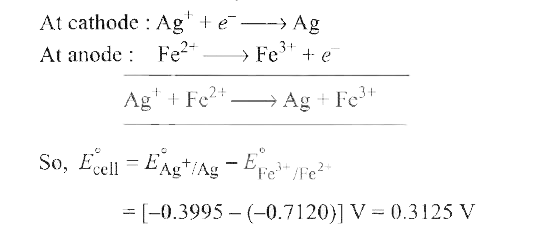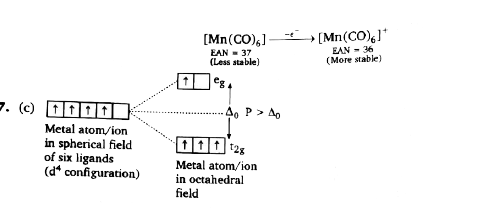InterviewSolution
This section includes InterviewSolutions, each offering curated multiple-choice questions to sharpen your knowledge and support exam preparation. Choose a topic below to get started.
| 7201. |
Which of the following statement is incorrect for KMnO_(4)? |
|
Answer» It is an oxidising agent |
|
| 7202. |
What is the chemical name of freon? |
| Answer» SOLUTION :The CHEMICAL NAME of FREON is Dichlorodifinoromethane. | |
| 7203. |
Treatment of 1-butene with conc. H_2SO_4 followed by treatment with water forms |
|
Answer» 1-butanol `CH_3CH_2CH=CH_2 OVERSET(H_2O // H_2SO_4)to CH_3CH_2CHOHCH_3` |
|
| 7204. |
Which compound most readily forms hydrogen bonds between its molecules in the liquid state? |
|
Answer» HBr |
|
| 7205. |
Which of the following are bidentate monoanion ligands ? (1) Acetylacetonato (2)Oxalato ion (3) Dimethylglyoxiamato Select the correct answer using the codes given below : |
|
Answer» 1 only 
|
|
| 7206. |
When alcohol reacts with conc. H_(2)SO_(4), intermediate compound formed is : |
| Answer» Answer :A | |
| 7207. |
Which one of the following compounds when heated with KOH and a primary amine gives carbylaminestest ? |
|
Answer» `CHCl_3` |
|
| 7208. |
The values of DeltaH and DeltaS for the reaction, C_(("graphite"))+CO_(2(g))rarr2CO_((g)) are 170 kJ and 170 JK^(-1), respectively. This reaction will be spontaneous at |
|
Answer» 710 K `0=(170xx10^(3)J)-T(170 JK^(-1))` T=1000 K For spontaneity, `DeltaG` is -ve Hence T should be `gt` 1000 K/ |
|
| 7209. |
Which one of the following is not a primary amine ? |
|
Answer» tert-Butylamine |
|
| 7210. |
Which defect creates when some P atom is added to Si ? |
|
Answer» Displacement DEFECT |
|
| 7211. |
Which of the following metals forms grignard reagent? |
|
Answer» Magnesium |
|
| 7212. |
The two half cell reactions of an electrochemical cell is given as thevalueof cellEMFwill be |
|
Answer» `-0.3125 V` Cellreactionswill be 
|
|
| 7213. |
You are given a 2.198 - g samplecontaining a mixture of XO and X_(2)O_(3) .It requires 0.015 mol of K_(2)Cr_(2)O_(7) to oxidise the samplecompletely to form XO_(4)^(-) and Cr^(3+) .If 0.0817 mole XO_(4)^(-)is formed ,what isthe atomic mass of X? |
Answer» Solution : Applying POAC for X atomsof atomic mass say x , MOLE of `XO+2xx` mole of `X_(2)O_(3) `mole of `XO_(4)^(-)` `m/(x+16) +(2(2.198 -m))/(2x+48) = 0.0187 ""…(1)` Applying law of equivalence , eq. of XO + eq. of `X_(2)O_(3) = " eq. of " K_(2)Cr_(2)O_(7)` `m/(x+16) xx 5 + ((2.198 -m))/(2x+48) xx 8 = 0.015 xx 6""...(2)` SOLVING eqns . (1) and (2), x = `100.04` |
|
| 7214. |
The unit cell of a metallic element of atomic mass 10^(8) and density 10.5 g/cm^(3) is a cube with edge length of 409 PM. The structure of the crystal lattice is - (A) fcc (B) bcc (C) hcp (D) None of these |
|
Answer» Solution :(A) `RHO=(ZxxM)/(Nxxa^(3))` Here,M=108, `N_(A)`=6.023xx10^(23)` Put on these values and solving we GET- a=409 PM=`4.09xx10^(-8)` cm. `rho=10.5 g//cm^(3)` n=4= number of ATOMS per unit CELL So, The structure of the crystal lattice is fcc. |
|
| 7215. |
Which of the following reacts with NaOH to produce an acid and alcohol ? |
|
Answer» `HCHO` |
|
| 7216. |
Which of the following is correct. |
|
Answer» `{:("CRYSTAL system","Axial DISTANCE","Axial angles","Examples"),("Cubic",aneb=c,alpha=betanegamma=,Cu","KCl):}` `a=b=c, alpha=beta=gammane90^(@)` |
|
| 7217. |
The volume of 0.1 M Ca(OH)_2required toneutralize 10 mL of 0.1 N HCI |
|
Answer» Solution :`0.1 M Ca(OH)_2 = 0.2 N Ca (OH)_2` APPLYING `N_1V_1 = N_2V_2` `0.2 XX V_1 = 0.1 xx 10` ` V_1 = (0.1 xx 10)/(0.2) =5mL` |
|
| 7218. |
XeF_6 +MF to M^(+) [XeF_7]^(-) . Here "M" is |
|
Answer» ALKALI METALS |
|
| 7219. |
Who explained the action of catalyst in adsorption theory? |
|
Answer» Berzellius |
|
| 7220. |
Which of the following relation is correct ? (i) x/ = constant at high pressure (ii) x/m = constant xx p^(1//n) (at intermediate pressure) (iii) x/m = constant xxp^(n) (at lower pressure) |
|
Answer» all are CORRECT |
|
| 7221. |
Which ions can be tested in a solution of Mohr's salt? |
|
Answer» Solution :Composition of Mohr.s salt is `FeSO_(4) (NH_(4))_(2)SO_(4).6H_(2)O`. It is a double salt. It undergoes complete ionisation when DISSOLVED in water. Thus its AQUEOUS solution gives test for `Fe^(2+), NH_(4)^(+)` and `SO_(4)^(2-)` ions. |
|
| 7222. |
The solubility of Sb_(2)S_(3) in water is 1.0 xx 10^(-5) mole/litre at 298 K. What will be its solubility product |
|
Answer» `108 xx 10^(-25)` `K_(sp) = 108x^(5), K_(sp) = 108 xx (1 xx 10^(-5))^(5) = 108 xx 10^(-25)`. |
|
| 7223. |
Which of the following halogen acids has the lowest melting point: |
|
Answer» HF |
|
| 7224. |
What is the basic structural difference between glucose and fructose ? |
| Answer» Solution :GLUCOSE has aldehydic GROUP while FRUCTOSE has ketonic group/Glucose is ALDOSE while fructose is ketose. | |
| 7225. |
What is the effect of adding a catalyst on activationenergy (E_(a)) ? |
| Answer» Solution :Activation ENERGY is lowered on ADDING a CATALYST. | |
| 7226. |
Tritium, ""_1^3His a radioactive nucleus of hydrogen. It is used in luminous watch dials. Tritium decays by beta emission with a half-life of 12.3 years. What is the decay constant (in s^(-1) )? What is the activity (in Ci) of a sample containing 2.5 mugof tritium? The atomic mass of tritium is 3.02 amu. |
| Answer» SOLUTION :`1.79 XX 10^(-9) // s , 0.024 CI` | |
| 7227. |
What is the major product when anisole is treated with Br_(2) in ethanoic acid? |
| Answer» SOLUTION :p-bromoanisole | |
| 7228. |
What is sulfa drug? Name the key compounds of sulfa drugs. |
| Answer» Solution :Sulfa drugs are the compounds used to ACT against microorganisms for CURING diseases. The key compounds from which sulfa drugs are synthesised are sulfanilic acid and SULFANILAMIDE. | |
| 7229. |
Which scientists' names are associated with the isolation of aluminium from its ore? |
| Answer» SOLUTION :HALL and HEROULT. | |
| 7230. |
What is electronic arrangement of metal atom/ion in octahedral complex with d^(4) configuration, if Delta_(0) ltpairing energy? |
|
Answer» `t_(2g)^(4)e_(G)^(0)` 
|
|
| 7231. |
Which one of the following reaction is an example of free radical substitution reaction? |
|
Answer»
|
|
| 7232. |
The value of PV for 5.6 litres of an ideal gas is.. RT, at N.T.P. |
| Answer» SOLUTION :APPLY `=(PV)_(MAX) =nRT_("max")` | |
| 7233. |
The strength of van der Waals' forcesincrease with : |
|
Answer» INCREASE in molecular size |
|
| 7234. |
The units of molar conductivity are : |
|
Answer» `ohm^(-1)CM^(-2) mol^(-1)` |
|
| 7235. |
Which statement about molecularity of a reaction is wrong: |
|
Answer» It is the NUMBER of molecules of the REACTANTS taking part in a single STEP of reaction |
|
| 7236. |
Which of the following reactions does not involve decarboxylation? |
| Answer» Answer :D | |
| 7237. |
Which of the following will liberate CO_(2) on reaction with NaHCO_(3) |
|
Answer»
|
|
| 7238. |
Whose elevation in boiling point will be the same as for 0.1 m KNO_(3) ? |
|
Answer» 0.1 m UREA |
|
| 7239. |
Which of the following substance is not an antioxidant ? |
|
Answer» ASCORBIC acid |
|
| 7240. |
X is a non- volatile solute and Y is a volatile solvent. The following vapour pressures are observed by dissolving X in Y {:("X/mol lit"^(-1),"Y/mm of Hg"),(0.10,P_1),(0.25,P_2),(0.01,P_3):} The correct order of vapour pressure is |
|
Answer» `P_1 LT P_2 lt P_3` |
|
| 7241. |
The time required for 10% completion of a first order reaction at 298 K is equal to that required for its 25% completion at 308 K. If the per-exponential factor for the reaction is 3.56xx10^(9)s^(-1), calculate its rate constant at 318 K and also the energy of activation. |
|
Answer» SOLUTION :`t_(1)=(2.303)/(k_(1))log""(a)/(a-0.10a),t_(2)=(2.303)/(k_(2))log""(a)/(a-0.25a)` As `t_(1)=t_(2),(2.303)/(k_(1))log""(a)/(0.90a)=(2.303)/(k_(2))log""(a)/(0.75a),(k_(2))/(k_(1))=(log(100//75))/(log(100//90))=2.73` But `log(k_(2))/(k_(1))=(E_(a))/(2.303" R")((T_(2)-T_(1))/(T_(1)T_(2)))` Putting `k_(2)//k_(1)=2.73,R=8.314" J K"^(-1)mol^(-1),T_(1)=298" K",T_(2)=308" K, we get "E_(a)=76.6" KJ mol"^(-1)` Further, `k="Ae"^(-E_(a)//"RT")" or "logk=log A-(E_(a))/(2.303" RT")` Putting `A=3.56xx10^(9)s^(-1),R=8.314xx10^(-3)"kJ K"^(-1)mol^(-1),E_(a)=76.6" kJ mol"^(-1),T=318" K",` we get `k=9.3xx10^(-4)s^(-1)` |
|
| 7242. |
The type of forces present among halogen molecules |
|
Answer» H- bonds |
|
| 7243. |
What are synthetic detergents ? Give one example. |
|
Answer» SOLUTION :Synthetic detergents are CLEANSING agents which have all the properties of soap but which actually do not contain any soap. These can be used in both soft and hard water. CATIONIC detergents such as cetyltrimethyl AMMONIUM bromide and anionic detergents such as sodium laurylsulphate. Non-ionic detergents such as polyethylene GLYCOL stearate. |
|
| 7244. |
Whichof the following is not true ? |
|
Answer» In vulcanization , the FORMATION of sulphur bridge between different CHAINS make rubber hard and STRONG |
|
| 7245. |
Which one of the following acids has highest heat of neutralization with one equivalent of NaOH? |
| Answer» ANSWER :C | |
| 7246. |
Two compounds each containing only tin and oxygen had the following composition: {:(,"Mass % of tin","Mass % of oxygen"),("Compound A",78.77,21.23),("Compound B",88.12,11.88):} Show how this data illustrate the law of multiple proportions? |
|
Answer» Solution :In compound A 21.23 parts of oxygen combine with 78.77 parts of tin 1 part of oxygen combines with 78.77/21.23=3.7 parts of tin In compound B 11.88 parts of oxygen combine with 88.12 parts of tin 1 part of oxygen combines with 88.12/11.88=7.4 parts of tin Thus, the mass of tin in compound. A and B which combine with a fixed mass of oxygen are in the ratio of 3.7:7.4 or 1:2. this is a SIMPLE ratio. HENCE, the DATA ILLUSTRATE the law of MULTIPLE proportions. |
|
| 7247. |
Which resonating structure is most stable? |
|
Answer»
|
|
| 7248. |
Which metal is not used for making coins ? |
|
Answer» Gold |
|
| 7249. |
Which of the following following IUPAC names are correct : |
|
Answer»
|
|
| 7250. |
Whatare essentialand non - essentaialamino acids ?Givetow exampleof eachtype . |
|
Answer» Non - essentialaminoacids: Theaminoacids whichcan be synthesised in the body by itself areknown as non - essential amino acids . For example : GLYCINE, alanine . |
|